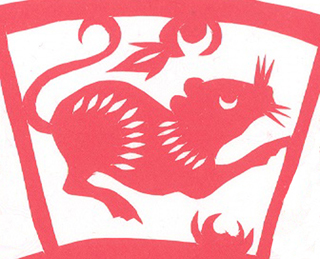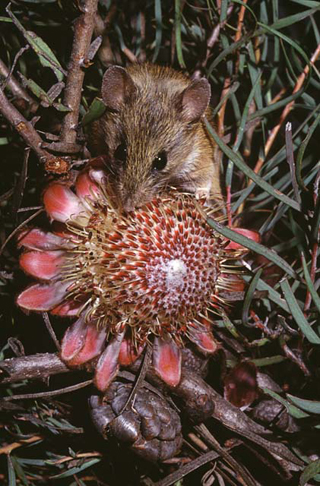Human Flower Project
Year of the Rat Pollinator
Bees and bats do it, as do mice—pollinate flowers, that is. Some of South Africa’s most marvelous low-to-the-ground species should have a banner year.

Paper cutout/Year of the Rat
Image: Hudson Museum
Happy New Year to all our Far Eastern readers, and anybody else who’s ready to start over…
Year of the Rat began February 7 and will extend through January 25 of next year. As usual, the stock market swamis are chiming in (though we haven’t yet seen a rodent festooned at Korea’s stock exchange, as an ox was in 2006).
But no matter what the dollar and yuan do, 2008 should be terrific for proteas and the succulent karoo. Both are therophilous plants, meaning they’re pollinated by rodents (“rats,” if you like).
 Namaqua Rock Mouse (
Namaqua Rock Mouse (
Photo: Colin Paterson Jones
This gorgeous photo, by Colin Paterson Jones, shows a Namaqua Rock Mouse pollinating Protea humiflora (protea is the national flower of South Africa). Not mice only, but shrews, gerbils, and—yes, rats—visit several of the low-to-the-ground species of proteas and Hook Pincushions.
“Rodents are attracted by a strong musty odour, and a reward of syrupy sugar which is secreted in large quantities. In order to prevent birds and insects from stealing this nectar, rodent-pollinated (therophilous) proteas have inconspicuous brown or black involucral bracts. Flower-heads are usually hidden inside the bush at ground level, where they are accessible to rodents. The insides of the involucral bracts may be pale white and the tips of the flowers may be shiny red – both serve to guide the rodent to the nectar in the dark.” Here’s much more about the experiments, photos, too.
Steven D. Johnson, a botanist at the University of Natal in Petermaritzburg, South Africa, set up a night experiment to discover the pollinators of the dramatic Massonia depressa, also known as Succulent Karoo: “Imagine water lily leaves spread on the ground,” says Johnson. He and his team released gerbils in an enclosed area around the plant “and the rodents dove for nectar, leaving the flower intact but their snouts gilded with pollen.”
Here’s more on Year of the Rat, including a description of rat-natives’ more and less appealing traits. For proteas and succulent karoo, the most vital of these is certainly industriousness. Get down!
Comments
Very interesting, Julie, and this makes me wonder if it would work better to bait a rat-trap with a few drops of “essence of protea” instead of using cheese or peanut butter.
Annie at the Transplantable Rose


It is amazing what lengths plants will go to be pollinated. I just read an article about a carnivorous plant that ate mice.